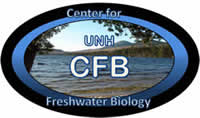Abstract
Cyanobacteria reduce the fitness of many Daphnia species, and blooms in eutrophic lakes may place strong selective pressure upon these primary consumers. This study examines the ability of daphnids to resist the deleterious effects of toxic Microcystis and determine if this resistance is related to the trophic conditions of their native lakes. Three populations of Daphnia pulex/pulicaria were examined; D. pulicaria from eutrophic Klamath Lake in Oregon, D. pulex from eutrophic Old Durham Reservoir in New Hampshire, and D. pulicaria from oligotrophic Russell Pond in New Hampshire. D. carinata from meso-oligotrophic Lake Rotoaira in New Zealand was used as a known cyanobacteria-sensitive species. Ten-day old 5th-6th instar animals were exposed to a mixture of Microcystis aeruginosa and Chlorella vulgaris (25% and 100% M. aeruginosa). Body length, lipid index, reproductive index and clearance rate were assessed for each population after 120 hours of treatment. A feeding bioassay response quantifying the energetic (feeding rate) cost of post abdominal rejections was also determined for a gradient of M. aeruginosa concentrations from 0% to 100%. The four populations of Daphnia exhibited different rates of decline in overall fitness when exposed to Microcystis. Populations exposed to Microcystis exhibited reduced thoracic beat rate, lower lipid and reproductive indexes, and higher cost of post abdominal rejections in comparison to daphnids in the control Chlorella. Length was not a sensitive indicator of fitness level. D. pulex from eutrophic Klamath Lake had a mean clearance rate in 100% Microcystis that was three to four times higher than D. pulicaria from oligotrophic Russell Pond. In general, daphnids from oligotrophic lakes exhibited a more drastic decline in fitness than daphnids from eutrophic lakes. This suggests that taxonomically related populations of Daphnia have evolved a suite of adaptations to Microcystis depending upon their history of exposure.
Publication Date
1-1-2002
Publisher
UNH Center for Freshwater Biology Research
Document Type
Article
Recommended Citation
Blanchette, Melanie L. and Haney, James F., "The effect of toxic Microcystis aeruginosa on
four different populations of Daphnia" (2002). Center for Freshwater Biology. 13.
https://scholars.unh.edu/cfb/13

